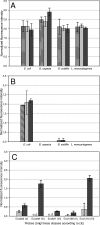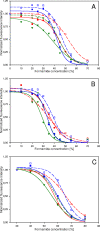Double labeling of oligonucleotide probes for fluorescence in situ hybridization (DOPE-FISH) improves signal intensity and increases rRNA accessibility
- PMID: 19966029
- PMCID: PMC2813028
- DOI: 10.1128/AEM.02456-09
Double labeling of oligonucleotide probes for fluorescence in situ hybridization (DOPE-FISH) improves signal intensity and increases rRNA accessibility
Abstract
Fluorescence in situ hybridization (FISH) with singly labeled rRNA-targeted oligonucleotide probes is widely applied for direct identification of microbes in the environment or in clinical specimens. Here we show that a replacement of singly labeled oligonucleotide probes with 5'-, 3'-doubly labeled probes at least doubles FISH signal intensity without causing specificity problems. Furthermore, Cy3-doubly labeled probes strongly increase in situ accessibility of rRNA target sites and thus provide more flexibility for probe design.
Figures


Similar articles
-
Flow cytometric analysis of the in situ accessibility of Escherichia coli 16S rRNA for fluorescently labeled oligonucleotide probes.Appl Environ Microbiol. 1998 Dec;64(12):4973-82. doi: 10.1128/AEM.64.12.4973-4982.1998. Appl Environ Microbiol. 1998. PMID: 9835591 Free PMC article.
-
Making all parts of the 16S rRNA of Escherichia coli accessible in situ to single DNA oligonucleotides.Appl Environ Microbiol. 2006 Jan;72(1):733-44. doi: 10.1128/AEM.72.1.733-744.2006. Appl Environ Microbiol. 2006. PMID: 16391113 Free PMC article.
-
In situ accessibility of Saccharomyces cerevisiae 26S rRNA to Cy3-labeled oligonucleotide probes comprising the D1 and D2 domains.Appl Environ Microbiol. 2003 May;69(5):2899-905. doi: 10.1128/AEM.69.5.2899-2905.2003. Appl Environ Microbiol. 2003. PMID: 12732564 Free PMC article.
-
Single-cell identification in microbial communities by improved fluorescence in situ hybridization techniques.Nat Rev Microbiol. 2008 May;6(5):339-48. doi: 10.1038/nrmicro1888. Nat Rev Microbiol. 2008. PMID: 18414500 Review.
-
Oligonucleotide probes for RNA-targeted fluorescence in situ hybridization.Adv Clin Chem. 2007;43:79-115. Adv Clin Chem. 2007. PMID: 17249381 Review.
Cited by
-
Visualizing in situ translational activity for identifying and sorting slow-growing archaeal-bacterial consortia.Proc Natl Acad Sci U S A. 2016 Jul 12;113(28):E4069-78. doi: 10.1073/pnas.1603757113. Epub 2016 Jun 28. Proc Natl Acad Sci U S A. 2016. PMID: 27357680 Free PMC article.
-
Multiple single-cell genomes provide insight into functions of uncultured Deltaproteobacteria in the human oral cavity.PLoS One. 2013;8(3):e59361. doi: 10.1371/journal.pone.0059361. Epub 2013 Mar 26. PLoS One. 2013. PMID: 23555659 Free PMC article.
-
New methods for analysis of spatial distribution and coaggregation of microbial populations in complex biofilms.Appl Environ Microbiol. 2013 Oct;79(19):5978-87. doi: 10.1128/AEM.01727-13. Epub 2013 Jul 26. Appl Environ Microbiol. 2013. PMID: 23892743 Free PMC article.
-
Testing Anti-Biofilm Polymeric Surfaces: Where to Start?Int J Mol Sci. 2019 Aug 3;20(15):3794. doi: 10.3390/ijms20153794. Int J Mol Sci. 2019. PMID: 31382580 Free PMC article. Review.
-
Fluorescence In Situ Hybridization for Diagnosis of Whipple's Disease in Formalin-Fixed Paraffin-Embedded Tissue.Front Med (Lausanne). 2017 Jun 22;4:87. doi: 10.3389/fmed.2017.00087. eCollection 2017. Front Med (Lausanne). 2017. PMID: 28691008 Free PMC article.
References
-
- Amann, R., and B. M. Fuchs. 2008. Single-cell identification in microbial communities by improved fluorescence in situ hybridization techniques. Nat. Rev. Microbiol. 6:339-348. - PubMed
-
- Behrens, S., C. Ruhland, J. Inacio, H. Huber, A. Fonseca, I. Spencer-Martins, B. M. Fuchs, and R. Amann. 2003. In situ accessibility of small-subunit rRNA of members of the domains Bacteria, Archaea, and Eucarya to Cy3-labeled oligonucleotide probes. Appl. Environ. Microbiol. 69:1748-1758. - PMC - PubMed
-
- Daims, H., S. Lücker, and M. Wagner. 2006. daime, a novel image analysis program for microbial ecology and biofilm research. Environ. Microbiol. 8:200-213. - PubMed
-
- Daims, H., K. Stoecker, and M. Wagner. 2005. Fluorescence in situ hybridization for the detection of prokaryotes, p. 213-239. In A. M. Osborn and C. J. Smith (ed.), Advanced methods in molecular microbial ecology. Bios-Garland, Abingdon, United Kingdom.
Publication types
MeSH terms
Substances
Grants and funding
LinkOut - more resources
Full Text Sources
Molecular Biology Databases

